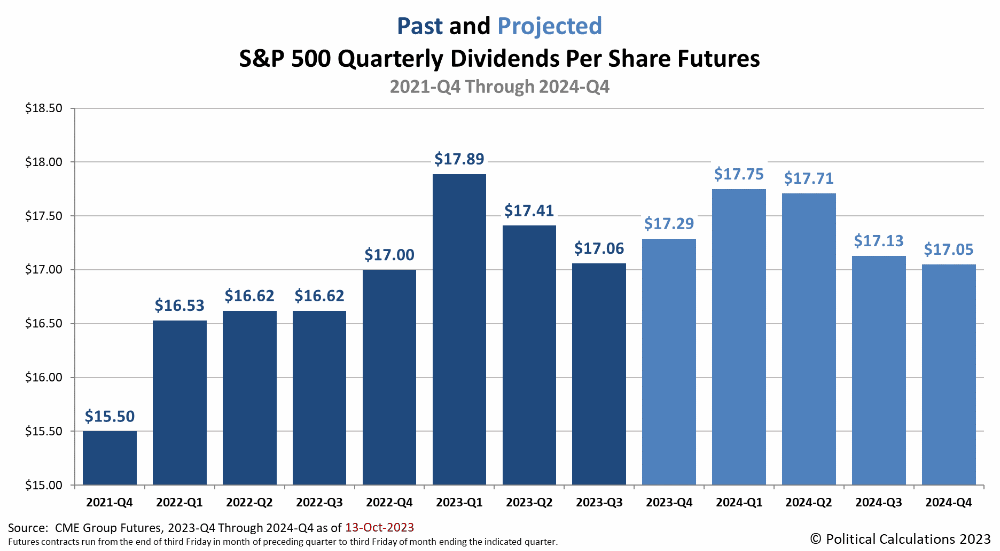The outlook for S&P 500 (Index: SPX) quarterly dividends per share continued to improve during the month since our first snapshot of the future for the index' dividends per share through each quarter of 2024.
In between then and now, the outlook dimmed as long term interest rates spiked at the end of October 2023 before brightening in the weeks since. Going into the 14 November 2023 trading day, projected dividends have risen for each quarter from the current 2023-Q4 through 2024-Q4.
We captured the snapshot before the better-than-expected U.S. consumer price inflation report was released on 14 November 2023, so we have a good baseline from which to see how the accompanying changes in expectations affects the outlook for S&P 500 dividends per share plays out in future updates. As for how things have changed since our previous update, here is an animated chart providing that information.
For the current quarter of 2023-Q4, the amount of dividends expected to be paid out over the life of the quarter's dividend futures contracts increased by 2.1% from $17.29 per share to $17.66 per share. This change corresponds with the improvements we've generally seen as the recovery from the S&P 500's 2022 earnings recession has progressed.
Although the outlook brightened for each future quarter in our field of view, there remains a dark cloud on the time horizon for investors. The drop in expected dividends per share for the S&P 500 index between 2024-Q2 and 2024-Q3 is substantial. Since quarterly dividends are a mildly lagging-to-contemporary economic indicator, that dropoff suggests investors anticipate a rough experience for dividend-paying firms arriving in or by 2024-Q2. That timing coincides with when investors are betting the Federal Reserve will be forced by worsening economic conditions to start cutting interest rates.
We'll take our next regularly scheduled snapshot of the outlook for the S&P 500's quarterly dividends per share in three months, although we'll revisit the future for S&P 500 dividends with a special edition if anything exciting happens with them before that time.
More About Dividend Futures Data
Dividend futures indicate the amount of dividends per share to be paid out over the period covered by each quarter's dividend futures contracts, which start on the day after the preceding quarter's dividend futures contracts expire and end on the third Friday of the month ending the indicated quarter. So for example, as determined by dividend futures contracts, the now "current" quarter of 2023-Q4 began on Saturday, 16 September 2023 and will end on Friday, 15 December 2023.
That makes these figures different from the quarterly dividends per share figures reported by Standard and Poor. S&P reports the amount of dividends per share paid out during regular calendar quarters after the end of each quarter. This term mismatch accounts for the differences in dividends reported by both sources, with the biggest differences between the two typically seen in the first and fourth quarters of each year.
Labels: dividends, forecasting, SP 500
Welcome to the blogosphere's toolchest! Here, unlike other blogs dedicated to analyzing current events, we create easy-to-use, simple tools to do the math related to them so you can get in on the action too! If you would like to learn more about these tools, or if you would like to contribute ideas to develop for this blog, please e-mail us at:
ironman at politicalcalculations
Thanks in advance!
Closing values for previous trading day.
This site is primarily powered by:
CSS Validation
RSS Site Feed
JavaScript
The tools on this site are built using JavaScript. If you would like to learn more, one of the best free resources on the web is available at W3Schools.com.
